The (Not So) Secret Origin of Maro
It's Magic Origins Story Week where all of us on the website are sharing our Magic origin stories with all of you. One small problem for me personally was I've already written my Magic origins story during our last Origins Story Week. That week was about Magic's origin but as I wrote the feature story about the game's origin, I wrote my column about my Magic origin. It was called "Once Upon a Time." For today, I decided to tell my Magic origin story again but this time talk about it in a slightly different way than I did last time. I'll hit a few points from "Once Upon a Time" but I'm deviating from it, so for the fuller picture I'd also read it as well.
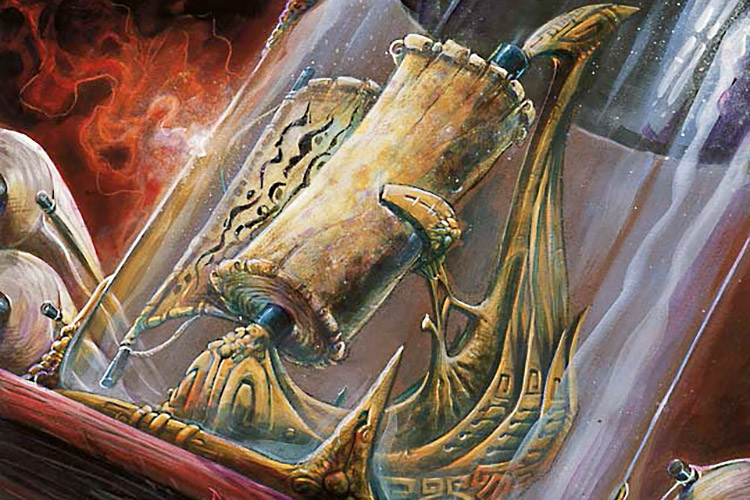
Scroll of Origins | Art by Dany Orizio
In the Beginning
I was born on May 25, 1967 in Biloxi, Mississippi. My father, Gene, was in the Air Force at the time, stationed at Keesler Air Force Base. The Vietnam War was going on and, rather than risk getting drafted, my dad volunteered on the promise that he could be stationed in the U.S. He was a dentist and so had skills that were useful for the base. My dad was in the Air Force for two years, during which time both I and my younger sister (and only sibling) Alysse were born. After my dad's stint in the Air Force, my parents returned to their hometown of Cleveland, Ohio. My dad started a dental practice and my mother, Lynne, became a psychologist specializing in treating adolescents. We built a house in a little suburb called Pepper Pike where I lived until I went off to college.
Each of my parents would have a big influence on me. My mom was very creative and loved writing. I started writing stories as soon as I was physically able to write the sentences (around age 4). I wrote all sorts of stories, but the thing I loved most was writing plays. I loved writing dialogue. I started getting involved in theater—acting, directing, and doing whatever I could to be involved with plays. All that time I kept writing. There was a local kids' playwriting contest that I won three years in a row, and all my plays got performed.
From my dad I got a love of games. My dad has been a lifelong gamer and he introduced me to all sorts of wonderful games. We had a giant cabinet full of games, and growing up I learned to play them all. My dad also introduced me to the world of puzzles. For my bar mitzvah (I'm Jewish for those that might be unaware), we invited my first grade teacher, who happened to live on our street, and as a gift she gave me Dungeons & Dragons. A game where I could make stuff up? I was hooked.
I was intellectually two years ahead but physically and emotionally two years behind. I was the smallest boy in my class and an easy target for bullying. My elementary and middle school years were rough, but I had a very supportive family and focused my attention on my passions: writing and games. In high school, I managed to get a better sense of who I was and avoided a lot of my younger angst. I spent most my extracurricular time doing theater and working on the school newspaper. I also became more and more interested in pop culture. (For a glimpse of my trials and tribulations with girls during high school and after, read my column "Topical Blend #1: To Err Is Human".)
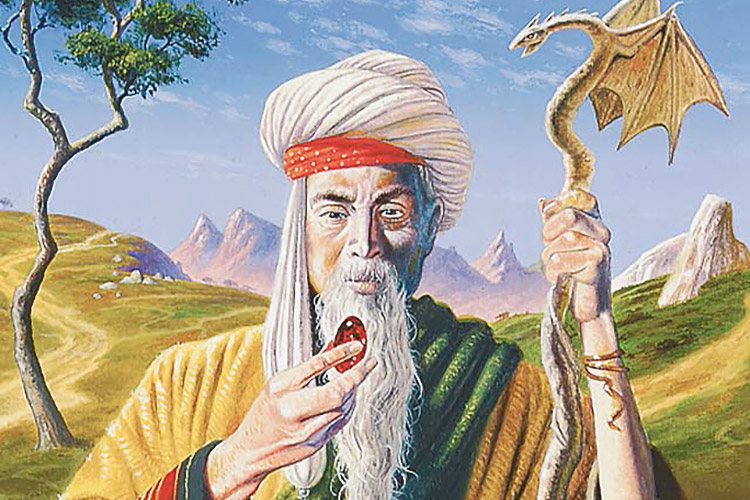
Worldly Tutor | Art by David O'Connor
The Old College Try
I feel that college is where I really came into my own. First, I discovered the College of Communications at Boston University and realized that my love of pop culture and writing made communications a perfect fit. I majored in Broadcast & Film with a minor in screenwriting. This meant I got to spend a lot of classes, and time between classes, watching many television shows and movies. It was during this time that I grew to really appreciate the structure that goes into telling stories through various mediums.
Second, I discovered Stage Troupe, the Boston University theater organization. I had a lot of creative energy to expend and they were more than willing to help me expend it. During my college years, I started an improvisational comedy troupe named Uncontrolled Substance. I began a sketch comedy program called the Writer's Workshop. And I wrote and produced two plays Leggo My Ego and Last Impressions. The first went inside a character's head where his emotions were arguing about a major life decision. (This play predated the television show "Herman's Head" and, obviously, the new Pixar film "Inside Out".) The second was a romantic comedy told backwards. (Okay, Harold Pinter beat me to that one but his was a drama.)
Third, I befriended a group of game players. We would get together once a week to play games. When we ran out of the games we had, we started going to a local game store and buying new ones. It was with this group that I first learned how to adapt existing games. We'd always start by trying the game as the box suggested, but from then on we took the matter into our own hands, tweaking the game to our liking. Part of being a good game designer is having the opportunity to play a lot of different games, and my gaming group in college was a great way to do this.
I walked away from college with a few things. From my school, I got a BS in communications (no, really) and learned a lot of skill and craft about how one creates and uses communication. A lot of my writing in this column comes from the lessons I learned in college. From Stage Troupe, I got a lot of hands-on experience and confidence that I had some writing chops. From my gaming group, I started to get an understanding of what makes games tick. I got very good at seeing mistakes even before we got to playing the game.
The last thing I got from college was a direction for my life. I had always been a huge fan of television. It was a medium that allowed you to tell many stories stretched over a long period of time and that, as a writer, intrigued me. I decided I wanted to create television shows which meant that I needed to move to Los Angeles. (To see some of the life lessons I learned at college among other places, see part 1 & part 2.)
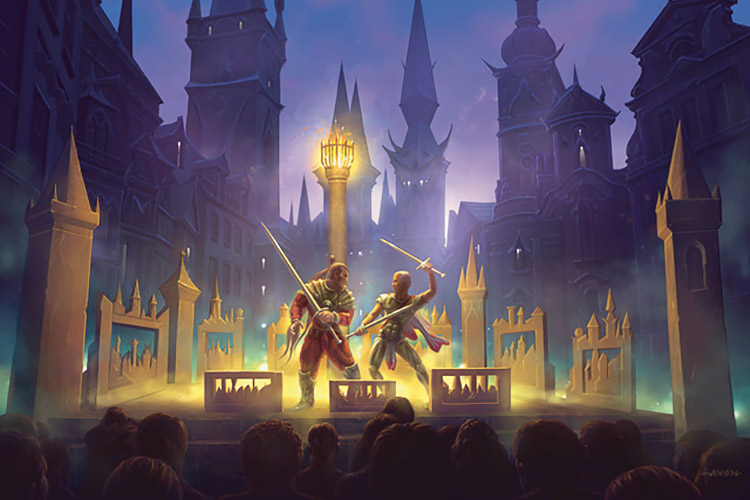
Thespian's Stage | Art by John Avon
The City of Angels
I had figured out what I wanted to do with my life. Now all I had to do was make it happen. I had applied for an internship during the summer of my junior year. It looked like I was very close to getting it when all of Hollywood shut down due to a writer's strike which lasted all summer long. I still spent the summer in L.A. doing research, so I was at least a little more comfortable with the town. After graduation I moved out there.
I knew the trick was to start at the bottom and work my way up. I needed to get what was known as a production assistant job (also known as a "runner"), which is the absolute lowest rung of Hollywood's job ladder. Even that, however, I didn't know how to get. One day, I snuck onto a lot thinking that I needed to get myself more familiar with the places I was trying to get hired. I ended up walking into an interview which clearly wasn't for me but, the actual recipient was a no-show so I did the interview. I ended up getting hired for a few weeks' work on television show called "It's Garry Shandling's Show!"
That job led to a television retrospective special, which led to a stint on a stand-up comedy show for HBO, which led to a stint working on the Emmys, which led to a stint on the pilot of a hidden camera show, which led to a stint working on a television show called "Anything but Love" starring Jamie Lee Curtis and Richard Lewis. And that gig got me to my longest production assistant job, working at Witt/Thomas Productions on a television show called "Empty Nest" with Richard Mulligan. The show was a spin-off of "The Golden Girls," which was also made by the same company. (For more on the tales of my times as a runner, read my columns "Tales of a Runner" and "Celebrity.")
Being a production assistant is a thankless task. You're underpaid, overworked, and treated shabbily by many. But it's a place to get your foot in the door and start making connections that can help you. Witt/Thomas Productions is where I had my first big break. One of the guys higher up at the company had a wife named Talia who decided she wanted to be an agent. She was looking for new, young talent and, as I had worked hard to make everyone aware of my goal to become a writer, I was able to get her to read some of my spec scripts ("spec" stands for speculative, which means a script you've chosen to write on your own time without being paid for it; in television, you write scripts from popular shows to demonstrate you can write for television). Talia liked my scripts and signed me on as her very first client.
I had a number of interviews and sit-down chats. I also had a number of pitches where I went in with ideas for the show I was pitching to. One of my pitches was for the show "Roseanne." I went in with ideas for ten shows and the pitch went so well that instead of just buying a story, I was hired on staff. Getting a staff offer from what is called a "cold pitch" is rare, so I was very excited. "Roseanne" was also the number-one rated show at the time and a program I greatly respected, so I couldn't have asked for a better first writing gig.
The job ended up being a bit more chaotic than I had hoped and my option wasn't picked up (aka I was let go). Talia then decided she didn't want to be an agent anymore, so I was passed to the agent she worked for named Marcie (who, interestingly, many years later would go to jail for embezzlement), who passed me on to a man named Doug. He was later fired, and I was passed along to a woman whose name I can't even remember. All I do remember is she wanted nothing to do with me and wouldn't return my calls. Interestingly, this career downslide would push me to a whole different career. (For more on my time on "Roseanne", read my three-part article.)
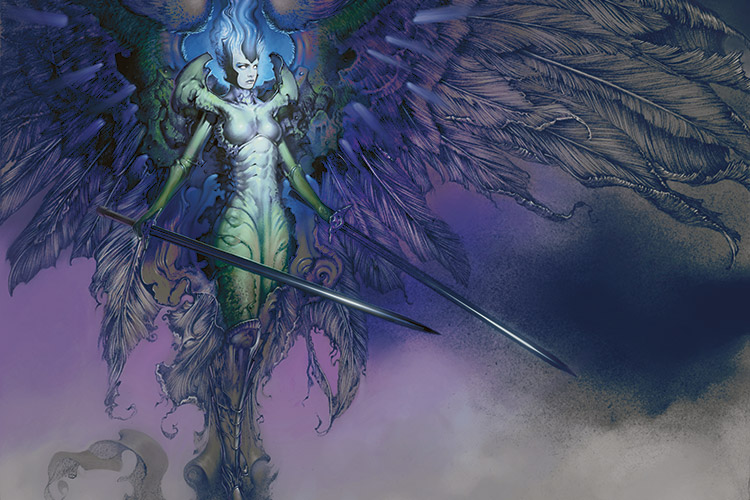
Indomitable Archangel | Art by Allen Williams
When One Door Closes
While I pursued my love of writing as a career, I pursued my love of games as a hobby. I never found a gaming group in Los Angeles like I had in Boston. My friends and I got together for roleplaying (we alternated between a Dungeons & Dragons campaign that I played in, and a Gamma World campaign that I ran) but they were a less hard-core group of gamers.
While starting to jumpstart my writing career, I took a part-time job at a game store to keep from going stir crazy. It was at the game store that I first heard about Magic. People kept coming in and asking if we had it, and with each question I would inquire more about it. It wasn't a game I had ever seen but all the inquisitions were making me very curious.
Quick aside. In Magic's early days, the product was slowly rolled out, starting on the West Coast, because Peter Adkison, a co-founder of the company and its first CEO, drove up and down the coast demoing the game. I just happened to be in the right place at the right time to hear about Magic when it first came out.
I soon got my hands on the game and was quickly hooked. Through the game, I started meeting other gamers like myself and all of a sudden I began to establish a whole new slew of friends. I dubbed them my Magic friends because there was no crossover between them and my other friends. Every Saturday, we would all go to the Costa Mesa Women's Center, which was the hot spot of Magic play in Southern California at that time. It was there that I got to know all the big Southern Californian Magic players.
In addition to Magic, I started dabbling in game design. I had always loved games and had enjoyed making up my own content for the role playing games I played, so I decided I wanted to try my hand at making games. I worked on a number of different games. Inspired by Magic, I made a trading card game where you constructed robots out of various components (each part represented by a card) to battle one another called Robobattle. I made a card game where two players fought each other using time travel called Time Duel (complete with anti-paradox rules). My favorite, at the time, was a little dice game I made called Mark's Little Dice Game (and later Polyhedra). I attended a GAMA conference in Las Vegas where I attended a conference on game design.
My big first Magic break came when I purchased the first Duelist magazine (a magazine about Magic published by Wizards) and found it lacking in content for more advanced players. To solve this problem, I came up with the idea for a puzzle column where players were put mid-game and had to solve a game state much like a chess puzzle. I met a Wizards employee named Steve Bishop at a local game convention and he offered to deliver my letter with samples of my puzzle column to Kathyrn Haines, the editor-in-chief of The Duelist. Kathryn loved the puzzle column and, before I knew it, "Magic: The Puzzling" was one of the most popular features in the magazine.
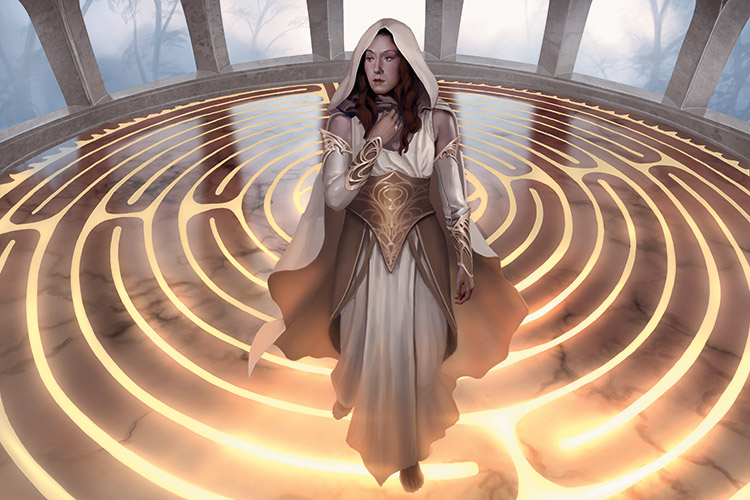
Meditation Puzzle | Art by Mark Winters
One day my maverick streak caught up with me at work. You see, the company had rules about not wearing tennis shoes, but the job required standing for eight hours at a time. I had tried other shoes, but they ended up with me being in great pain. I talked to my manager, who said it was okay to wear tennis shoes. (We spent most of the time behind the counter where the customers couldn't even see our shoes.) Six managers later, I was told I was breaking the rules. I said that I was unwilling to work in pain and that if I was forced to change shoes, I'd have to quit. As a part-time employee, I was the best salesman in the store, so they let me wear my tennis shoes. The next manager fired me the day he took over for reasons I don't know, but my best guess was I had a reputation from the shoes of being hard to work with.
Losing that job inspired me to do something to increase my involvement with Magic, so I flew myself to Gen Con (at the time in Milwaukee) to meet Kathryn face-to-face and convince her to let me write more for the magazine. I believe the conversation went like this:
Me: Hi, Kathryn. It's great to meet you.
Kathryn: Hi, Mark. It's great to finally meet you.
Me: I'm very interested in writing more for The Duelist.
Kathryn: You know Magic well, you're a good writer, and you turn your work in on time. I'd love to have you write more. Just pitch me article ideas and, if I like them, you can write them.
On the spot, I pitched her two article ideas: one about Gen Con from the perspective of a Magic player, and the other covering the game play of the finals of the very first World Championship happening at that year's Gen Con. She said yes to both and I spent the rest of the convention working on them. Those articles led to more articles, with me contributing multiple articles per month to the magazine. That work led to freelance work with seven other different sections of Wizards of the Coast. Apparently, knowing the game, writing well, and turning things in on deadline was attractive to everyone at Wizards.
The freelancing involved numerous trips. I was flown to Philadelphia for the 1995 U.S. Nationals and to Seattle for the 1995 World Championships. I was flown to Toronto for the very first ever Prerelease (it was for Ice Age). And numerous times I was flown up to Wizards corporate offices in Renton. It was there I got to meet more Wizards employees, including all of Magic R&D.
It was during one of my trips to Renton that a big idea hit me. I had chosen to make writing my career choice, but what if I chose games instead? My Hollywood career thus far had shown me the fickleness of the industry. I had really enjoyed all my work with Magic. What if instead of a hobby, I made it my career? Later that day I was talking to Mike Davis, the then-VP of R&D, when I said the fateful words "I'd be willing to move to Seattle." Mike's response, "When could you start?" (For more on my road to employment at Wizards, read my column "How to Get Your Dream Job".)

Angelic Destiny | Art by Jana Schirmer & Johannes Voss
Design Up Ahead
I wasn't hired as a designer but rather as a developer. I remember walking with Mike Davis and explaining to him that I felt my skills were more designer-oriented. Mike said they didn't need a designer. They had Richard Garfield. What they needed were more developers. Having learned the importance of getting your foot in the door, I took the job as a developer.
But even a developer gets to do a decent amount of a design. Whenever we would make holes in a development pass I would design a replacement, often taking cards from a giant file of designs I had already done. Green rare hole in Mirage? How about this cool creature I made, whose power and toughness is equal to the number of cards in your hand?
During my time as a developer, I got on good terms with all of the upper in management in R&D. I made sure they noticed that I was constantly hole-filling and that my designs were good. Then, when Richard Garfield let me know that he was interested in being on another design team, I made my move and convinced the Powers That Be to let me lead design for Tempest provided Richard was on the team.
Tempest's success helped shift perceptions of me from a developer to a designer. I did any and all design work I could, including design on many other games we made. Whenever I got the chance I would lead Magic designs and made sure that I was doing my best work. Then finally, back in December of 2003, I was asked by my then-boss, Randy Buehler, if I would be interested in becoming Head Designer. I said I was.
And that is the long strange trip from an Air Force base in Mississippi to the job I still hold today. (Along the way I met my wife—part 1 & part 2, got married—part 1 & part 2, and had a family—part 1 & part 2.)
Origin Magic
I hope you enjoyed learning a bit more about me and my road to my job as Magic head designer. Note there are a lot of links in today's column and, if you'd like to know more about any of the aspects I talked about, check out some of the other articles I've written. As this is a personal column, I'm extra interested in your feedback. You can write to me via email or any of my social media (Twitter, Tumblr, Google+, and Instagram).
Join me next week when everything is happily ever after...I mean happily evergreen.
Until then, may your own origin story be a cool one.
"Drive to Work #230—Dark Ascension, Part 2"
This is the second of a four-part series on the design of Dark Ascension.
"Drive to Work #231—Dark Ascension, Part 3"
This is the third of a four-part series on the design of Dark Ascension.
- Episode 231 Dark Ascension, Part 3 (15.8 MB)
- Episode 230 Dark Ascension, Part 2 (14.0 MB)
- Episode 229 Dark Ascension, Part 1 (16.0 MB)
- Episode 228 Legendary (13.7 MB)
- Episode 227 2009 (14.6 MB)
- Complete Drive To Work Podcast Archive

